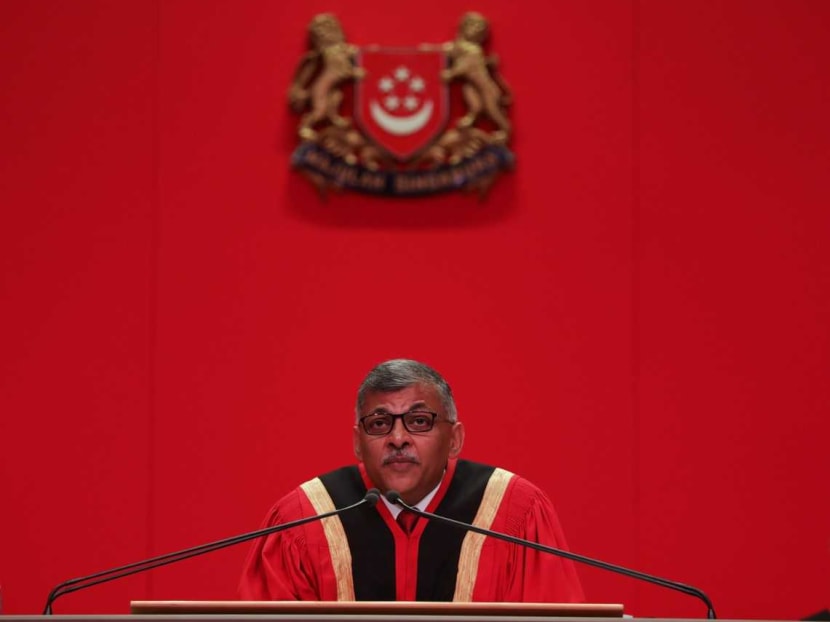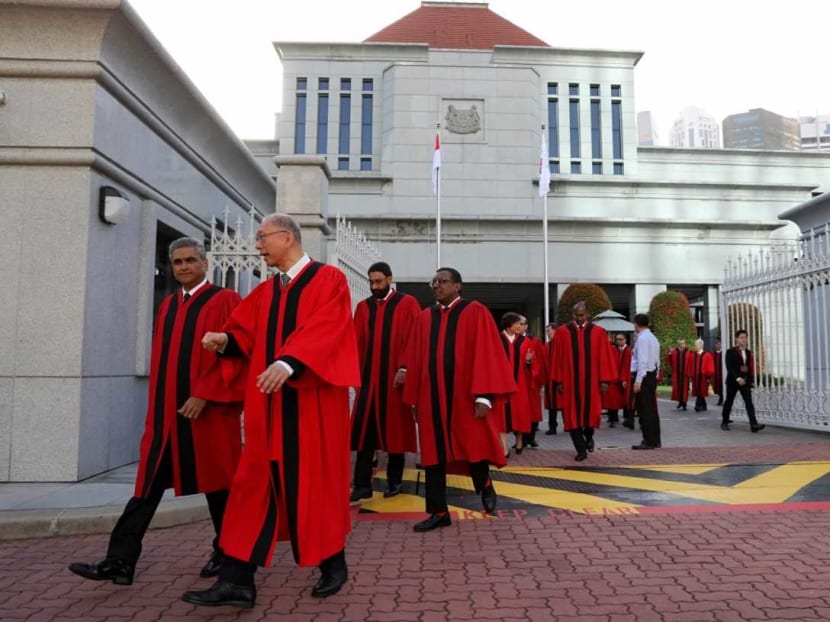Aspects of justice system set for ‘redesign’ to ensure it’s not the exclusive preserve of a few: Chief Justice
SINGAPORE — The Republic’s top judge on Monday (Jan 6) flagged potential tweaks to the justice system in the coming months to ensure that justice is available equally to everyone.

Chief Justice Sundaresh Menon said on Monday (Jan 6) that he and his staff will be looking at ways to redesign aspects of the justice system in the coming months.
SINGAPORE — The Republic’s top judge on Monday (Jan 6) flagged potential tweaks to the justice system in the coming months to ensure that justice is available equally to everyone.
At a ceremony to mark the opening of the 2020 legal year, Chief Justice Sundaresh Menon said justice should be not just “the exclusive preserve of a few”, but available equally to all Singaporeans.
Mr Menon said this could be achieved through a justice system that equalises access to justice, recognises that various disputes can be resolved in different ways, and strives to build lasting peace.
He said he and his staff will be considering how these values can be more effectively realised through “institutional redesign of aspects of our justice system” in the coming months.
This would help close the justice gap, which he said was a metaphor for the problem of unequal access to justice. Individuals could be deterred from seeking legal help due to costs, or could be unaware of their legal rights and remedies available.
“A justice system that seeks to minimise the level of injustice in society must necessarily be interested in closing each of these dimensions, thereby enhancing and equalising access to justice,” said Mr Menon at the Supreme Court ceremony.
Outlining his vision, Mr Menon said such a system will require the legal fraternity to embrace a different idea of a court which “proactively” resolves disputes, rather than taking the traditionally “reactive” approach.

Some of Singapore's judges attending the ceremonial opening of the 2020 legal year on Monday (Jan 6). Photo: Nuria Ling/TODAY
It would also give court users access to an extended suite of assistive services and actively connect the needy to help within or outside the justice system.
The court should also recognise that adjudication, which he described as the primary method of dispute resolution in an earlier era, should instead be seen as part of a range of measures, Mr Menon said.
“That model of justice is increasingly straining to meet the needs of modern society — one which is evolving faster than ever before, inhabits both online and offline worlds, faces increasing socio-economic stratification, and confronts a polarised world more prone to conflict and division than peace and multilateralism,” he said.
TECHNOLOGY AND THE ONLINE COURT
Mr Menon said technology can help with the solution: “Fortunately, the current era also offers a set of new and better tools — namely the potential of technology… The model of an online court, which advances each dispute through the stages of evaluation, facilitation and adjudication, is perhaps one of the most important of this new generation of possible solutions.”
To this end, he said the courts have implemented, or will be rolling out, technological developments to mitigate “persistent inefficiencies, delays, expenses and accessibilities within the existing court processes”.
For instance, a new Authentic Court Orders system, which was launched on Jan 2, will allow court users to retrieve court orders online through a QR code or the order’s reference number. This means those who need to show their court orders to others will no longer need to provide a certified true copy — a QR code reader is able to quickly establish the order’s authenticity.
The Supreme Court’s Office of Transformation and Innovation is also intending to pursue automated speech-to-text transcription services to provide real-time transcripts that are “reasonably accurate and affordable”, which would help quicken proceedings and reduce the need for lawyers to take verbatim notes, he said.
The State Courts have also enabled litigants-in-person — those who represent themselves in legal matters — to negotiate and mediate online, through its community justice and tribunals system. It is also working on an “outcome simulator” for motor accident cases to help parties identify potential award ranges for personal injuries, which could be expanded to other types of cases in future.
In another speech at the ceremony, Law Society president Gregory Vijayendran also exhorted the legal fraternity to “tune in to the voices of members of the public crying out for just outcomes and fair treatment”, citing author Richard Susskind’s recent book Online Courts and the Future of Justice.
Mr Vijayendran said citizens should be able to secure their own legal services. “If discussions about online courts are dominated by their impact on lawyers, we are asking the wrong questions. What matters above all is just outcomes for court users who feel they have been treated fairly,” he said, quoting Professor Susskind.
Said Mr Vijayendran: “Lawyers can, and should, bring value and have a unique value proposition. More needs to be done, without spin doctoring or self-indulgence, to share and socialise with our Singapore community the value and values proposition of Singapore lawyers practising in different practice areas.”
REFRESHING LEGAL EDUCATION
To figure out how to reshape Singapore’s legal profession, the courts had also held a series of conversations from May to August last year, involving more than 160 legal professionals in 16 focus group discussions.
Mr Menon revealed the main views and ideas that had emerged from these conversations, with the caveat that these ideas would “undoubtedly require further study to determine their viability”.
Participants agreed that there is a need to reimagine Singapore’s legal education and training, including ways to ensure greater diversity in the pathways that lead to admission to the Bar. Law schools could offer alternate pathways, such as four-year degree programmes with a final year component in business, accountancy or computer science.
Such a move would encourage those with complementary backgrounds and skill sets, such as those versed in computer science or those in science, technology, engineering and mathematics fields, to join the legal service, he said.
It might also be timely to review the undergraduate law syllabus to focus on other growth areas, such as in cross-border insolvency, international arbitration, e-commerce and financial services, participants said. Another suggestion to tweak the syllabus was to increase students’ exposure to core private law subjects in civil law systems, particularly those of China and Asean nations.
Other ideas include forming a steering forum that can guide the evolution of legal education and training and redesigning current continuing professional development courses.
LAW FIRMS OF THE FUTURE
The focus groups also found that while international law firms have been utilising technology and hiring tech experts, local law firms have “generally been less robust in embracing technological solutions”, said Mr Menon.
This is due to cost concerns and the lack of familiarity with technology, according to the discussions.
Said Mr Menon: “It was worrying to hear that some senior practitioners, particularly in small and medium-sized firms, have not embraced technology due to a general resistance to change. Given the increasing automation of routine legal tasks, such resistance raises difficult questions as to the longer term sustainability of these practices.”
Another topic was the expected rise in demand for a corps of allied legal professionals, who are not lawyers but are trained in complementary fields. This harked back to a previous speech by Mr Menon at the opening of the legal year 2019 on the possible emergence of a class of "legal technicians" who can provide services on less complex legal tasks with the help of technology.
Instead of the typical “pyramid” structure — a broad base of junior lawyers with a handful of partners at the top, Mr Menon said law firms may increasingly adopt a “rocket” structure, whereby “a central spine of lawyers is flanked by a range of allied legal professionals”.
These professionals may be trained in polytechnics and law schools, in areas such as litigation support, project management or business development.
“If this projection holds, it will have significant implications for the hiring and organisational practices of law firms, as well as the supply and demand of lawyers and allied legal professionals,” said Mr Menon.
Mr Menon said some of these initial ideas have been shared with the Law and Education Ministers and he expects them to be explored in 2020.











